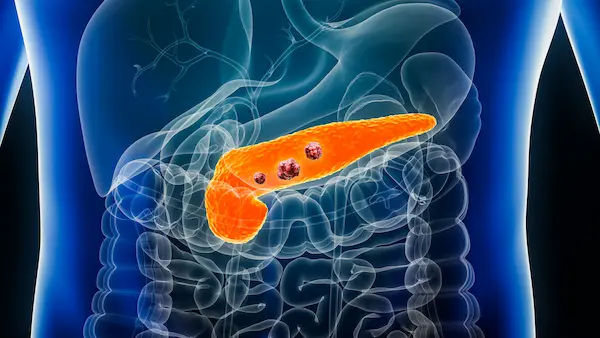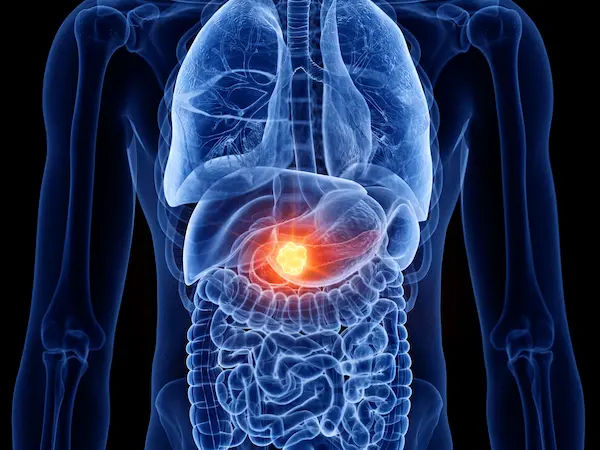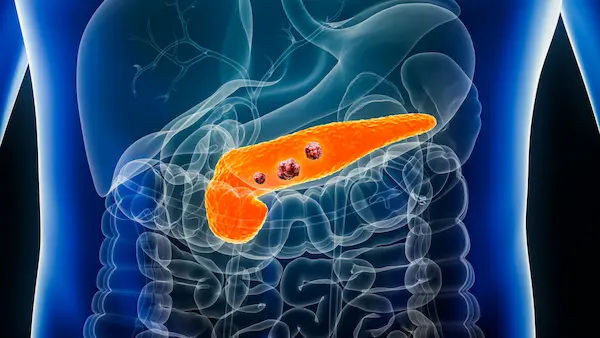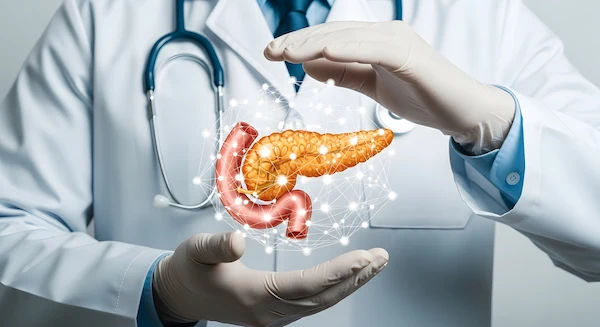Signs of Pancreatic Cancer: Recognising the Silent Symptoms
Pancreatic cancer can be hard to detect early. Learn about the key signs and symptoms, including jaundice, abdominal pain, and unexplained weight loss, and when it's important to see a doctor for a proper diagnosis.

Written by Dr. Dhankecha Mayank Dineshbhai
Reviewed by Dr. M L Ezhilarasan MBBS
Last updated on 30th Sep, 2025
.webp?tr=q-80,f-webp,w-350,dpr-2,c-at_max 700w)
Introduction
Pancreatic cancer often lurks in the shadows, earning its reputation as a "silent disease" because its early signs are frequently subtle, easily mistaken for more common ailments. Nestled deep within the abdomen, the pancreas can harbor a growing tumor for some time before it causes noticeable symptoms. This delay makes awareness critical. Understanding the potential warning signs of pancreatic cancer is the first step toward timely medical consultation, which can significantly impact outcomes. This article will guide you through the key symptoms, from the well-known, like jaundice, to the less obvious, such as sudden changes in blood sugar. We'll explain why these signs occur, how they might present differently based on the tumor's location, and, most importantly, what actionable steps to take if you or a loved one experiences them. Knowledge is power, and recognizing these signals can empower you to seek the expert evaluation necessary for early intervention.
Why Pancreatic Cancer is Often Called a "Silent Disease"
Pancreatic cancer's "silent" nature is not due to a lack of symptoms but rather their vagueness and late onset. In its early stages, a pancreatic tumor may cause no signs at all. Because the pancreas is located deep in the abdomen behind the stomach, small tumors don't press on other organs or nerves in a way that causes pain or discomfort initially. Furthermore, the early symptoms that do appear—such as indigestion, weight loss, or abdominal pain—are often attributed to everyday issues like heartburn, stress, or irritable bowel syndrome. This frequently leads to a delay in diagnosis until the cancer has advanced or spread. By understanding this challenge, we can become more vigilant about persistent or unusual changes in our bodies, even if they seem minor.
The Anatomy of the Pancreas and Its Hidden Location
The pancreas is a six-inch-long, pear-shaped organ hidden behind the stomach in the back of the abdomen. It plays a dual role: it produces digestive enzymes (exocrine function) and hormones like insulin that regulate blood sugar (endocrine function). Its deep-seated location is a primary reason why tumors can grow undetected. A mass must become relatively large or situated in a specific spot—like the head of the pancreas near the bile duct—to cause obstructive symptoms that are more readily identifiable, such as jaundice.
The Most Common Early Signs and Symptoms
While symptoms vary, several key signs should prompt a discussion with a healthcare professional. It's crucial to remember that having one or more of these symptoms does not mean you have pancreatic cancer; they are shared by many other conditions. However, their persistence is the key factor.
Consult Top Specialists
Jaundice: The Yellowing Warning Sign
Jaundice, characterized by yellowing of the skin and the whites of the eyes, is one of the most recognizable signs. It occurs when a tumor in the head of the pancreas blocks the bile duct, causing a buildup of bilirubin (a substance produced by the liver) in the blood. This is often one of the first noticeable symptoms for tumors in this location. Dark urine and pale, greasy stools are classic companions to jaundice.
Itchy Skin as a Related Symptom of Jaundice
A less-known but very bothersome symptom associated with jaundice is severe, generalized itching (pruritus). This occurs because the bilirubin deposits in the skin can cause irritation. If you develop jaundice accompanied by intense itching, it is a significant indicator that warrants immediate medical attention.
Unexplained Weight Loss and Loss of Appetite
Significant weight loss without trying is a common red flag for many cancers, including pancreatic cancer. This can happen for several reasons: the cancer itself consumes energy, a lack of digestive enzymes leads to poor nutrient absorption, and a loss of appetite is common. If you find yourself losing weight rapidly despite eating normally, or if food suddenly becomes unappealing, it's a symptom that should not be ignored.
Abdominal or Mid-Back Pain: A Key Distress Signal
Pain in the abdomen or back is a frequent symptom. The pain is often described as a dull ache that may radiate from the upper abdomen to the mid-back. This occurs as the tumor grows and presses against nearby nerves and organs. Unlike muscular back pain, this discomfort may worsen after eating or when lying down and might be relieved by leaning forward. Understanding what pancreatic cancer pain feels like can help distinguish it from more common back issues.
Other Important Symptoms to Watch For
Beyond the classic triad of jaundice, weight loss, and pain, other symptoms can provide important clues.
New-Onset Diabetes or Sudden Worsening of Control
The pancreas produces insulin. A tumor can impair this function, leading to the development of diabetes in someone with no prior history. For those already living with diabetes, a sudden and unexplained difficulty in controlling blood sugar levels can be a warning sign. Research is ongoing into the strong link between new diabetes and pancreatic cancer, viewing it as a potential early indicator.
Digestive Issues: Nausea, Changes in Stool, and Feeling Full
When a tumor blocks the release of pancreatic enzymes into the digestive tract, the body cannot properly break down fats. This leads to symptoms like nausea, vomiting, and steatorrhea—pale, floating, foul-smelling stools that are difficult to flush. A feeling of fullness after eating only a small amount of food is also common.
Blood Clots: A Less Common but Serious Sign
Sometimes, the first sign of pancreatic cancer is a blood clot in a large vein, often in the leg (deep vein thrombosis or DVT). This can cause swelling, pain, and redness. Cancer can increase the body's tendency to form clots. While blood clots have many causes, their occurrence alongside other symptoms on this list should be thoroughly investigated.
Symptoms Based on Tumor Location in the Pancreas
The specific symptoms can often be linked to where the tumor is located within the pancreas.
Signs of Tumors in the Head of the Pancreas
Tumors in the head of the pancreas are more likely to cause symptoms earlier because this area is close to the bile duct. Obstruction leads to jaundice, itchy skin, dark urine, and pale stools. This often allows for an earlier diagnosis compared to tumors in other parts of the pancreas.
Signs of Tumors in the Body or Tail of the Pancreas
Tumors in the body or tail of the pancreas can grow quite large before causing symptoms. When they do, they often present with abdominal pain that radiates to the back and unexplained weight loss. Because they are farther from the bile duct, they rarely cause jaundice in the early stages, which can delay diagnosis.
What To Do If You Experience These Signs?
If you are experiencing one or more of these symptoms persistently, the most important step is not to panic but to take action.
The Importance of a Detailed Medical History
When you consult a doctor, be prepared to provide a detailed history. Note when the symptoms started, their frequency, what makes them better or worse, and any other health changes you've noticed. This information is invaluable for your physician. If symptoms like jaundice, persistent abdominal pain, or unexplained weight loss persist beyond two weeks, consult a doctor online with Apollo24|7 for further evaluation. They can help assess your symptoms and guide you on the next steps.
Diagnostic Tests Your Doctor Might Recommend
If pancreatic cancer is suspected, your doctor may order several tests. These can include blood tests (like checking liver function and the tumor marker CA 19-9), and imaging scans such as a CT scan, MRI, or an endoscopic ultrasound (EUS). Apollo24|7 offers convenient home collection for tests like liver function tests (LFT) and CA 19-9, making the initial diagnostic process smoother.
Key Takeaways and Quick Summary
- Be Vigilant: Pancreatic cancer symptoms are often vague and easily mistaken for other conditions. Persistence is key.
- Know the Classics: Jaundice (yellow skin/eyes, dark urine, pale stools), unexplained weight loss, and persistent abdominal or back pain are the most common signs.
- Don't Overlook the Less Obvious: New-onset diabetes, severe digestive issues, and blood clots can also be indicators.
- Location Matters: Tumors in the head of the pancreas often cause jaundice earlier, while those in the body/tail may cause pain and weight loss first.
- Take Action: Do not ignore persistent symptoms. Early consultation with a healthcare professional is crucial for a proper diagnosis.
- You Are Your Best Advocate: Track your symptoms and communicate them clearly to your doctor to aid in diagnosis.
Conclusion
Recognizing the signs of pancreatic cancer is a critical component of proactive health management. While the disease's reputation as a "silent" illness is well-earned, being informed about its potential symptoms—from the obvious yellowing of jaundice to the subtle hint of new diabetes—empowers you to seek help at the earliest possible stage. It cannot be overstated that these symptoms are common to many less serious conditions. However, their persistence is what demands attention. If you notice a constellation of these warning signs that do not resolve, listening to your body and advocating for your health by consulting a medical expert is the most powerful step you can take. Timely diagnosis can open the door to more treatment options and better outcomes. Your vigilance could make all the difference.
Consult Top Specialists
Consult Top Specialists

Dr. Sanchayan Mandal
Medical Oncologist
17 Years • MBBS, DrNB( MEDICAL ONCOLOGY), DNB (RADIOTHERAPY),ECMO. PDCR. ASCO
Kolkata
MCR SUPER SPECIALITY POLY CLINIC & PATHOLOGY, Kolkata

Dr.sanchayan Mandal
Medical Oncologist
17 Years • MBBS, DrNB( MEDICAL ONCOLOGY), DNB (RADIOTHERAPY),ECMO. PDCR. ASCO
Kolkata
Dr. Sanchayan Mandal Oncology Clinic, Kolkata

Dr. Rupam Manna
Radiation Specialist Oncologist
4 Years • MBBS MD(RADIO THERAPY)
Barasat
Diab-Eat-Ease, Barasat

Dr. Sanchayan Mandal
Medical Oncologist
17 Years • MBBS, DNB Raditherapy, DrNB Medical Oncology
East Midnapore
VIVEKANANDA SEBA SADAN, East Midnapore

Dr Gowshikk Rajkumar
Oncologist
10 Years • MBBS, DMRT, DNB in Radiation oncology
Bengaluru
Apollo Clinic, JP nagar, Bengaluru
Consult Top Specialists

Dr. Sanchayan Mandal
Medical Oncologist
17 Years • MBBS, DrNB( MEDICAL ONCOLOGY), DNB (RADIOTHERAPY),ECMO. PDCR. ASCO
Kolkata
MCR SUPER SPECIALITY POLY CLINIC & PATHOLOGY, Kolkata

Dr.sanchayan Mandal
Medical Oncologist
17 Years • MBBS, DrNB( MEDICAL ONCOLOGY), DNB (RADIOTHERAPY),ECMO. PDCR. ASCO
Kolkata
Dr. Sanchayan Mandal Oncology Clinic, Kolkata

Dr. Rupam Manna
Radiation Specialist Oncologist
4 Years • MBBS MD(RADIO THERAPY)
Barasat
Diab-Eat-Ease, Barasat

Dr. Sanchayan Mandal
Medical Oncologist
17 Years • MBBS, DNB Raditherapy, DrNB Medical Oncology
East Midnapore
VIVEKANANDA SEBA SADAN, East Midnapore

Dr Gowshikk Rajkumar
Oncologist
10 Years • MBBS, DMRT, DNB in Radiation oncology
Bengaluru
Apollo Clinic, JP nagar, Bengaluru
More articles from Pancreatic Cancer
Frequently Asked Questions
What are the very first signs of pancreatic cancer?
There is no single 'first' sign, as it varies. Often, the earliest indicators are non-specific, such as unexplained weight loss, dull abdominal pain that may radiate to the back, or new-onset diabetes after the age of 50. Jaundice is a common early sign specifically for tumors located in the head of the pancreas.
Can pancreatic cancer be detected early?
Currently, there is no standard screening test for the general population. Early detection is challenging but is an area of active research. For individuals with a strong family history or known genetic syndromes, doctors may recommend regular monitoring with imaging tests like MRI or endoscopic ultrasound.
Is back pain a common symptom of pancreatic cancer?
Yes, persistent pain in the upper abdomen or mid-back is a common symptom. It is often described as a deep, dull ache that may worsen after eating or when lying down. This is different from typical muscle strain.
How is pancreatic cancer diagnosed?
Diagnosis typically involves a combination of a physical exam, blood tests, and imaging studies. A CT scan is the most common initial imaging test. A definitive diagnosis often requires a biopsy, where a small tissue sample is taken during an endoscopic procedure (EUS) or surgery.
Are there any signs of pancreatic cancer unique to women?
The signs and symptoms of pancreatic cancer are generally the same for both men and women. There are no gender-specific symptoms. The key is to be aware of the common symptoms and seek medical advice if they are persistent and unexplained.




